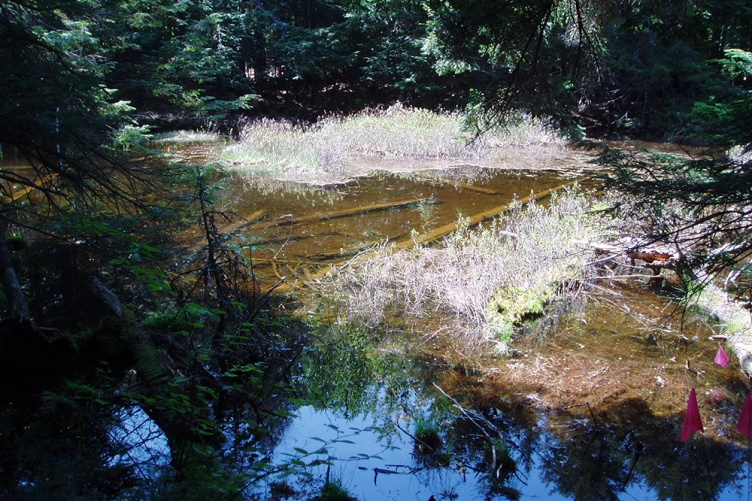

For many New Englanders, the high-chirp call of peepers signals the arrival of spring. While the loud call of the diminutive peeper can be heard at a great distance, other amphibians such as wood frogs and spotted salamanders also are “waking” from their winter dormancy and making their way to breeding ponds. Spring is the peak time for the migration of amphibians that rely on an important but often underappreciated type of wetland known as a vernal pool.
Scientists with the New Hampshire Agricultural Experiment Station (NHAES) at the University of New Hampshire have been studying vernal pools and their inhabitants for decades. Dr. Jessica Veysey Powell, a post-doctoral fellow in wildlife ecology and human dimensions of environmental management, works with Dr. Kimberly Babbitt, professor of natural resources and associate dean of academic affairs in the UNH College of Life Sciences and Agriculture who has been conducting research on amphibians for more than 20 years.
Vernal pools are isolated wetlands -- meaning they have no permanent inflow or outflow. In eastern North America, vernal pools are found within forested ecosystems, and because they dry completely in some years, vernal pools do not have permanent fish populations. “This makes them great habitats for species that are susceptible to fish predation. However, life within the wetland can be quite unpredictable. Species that thrive in vernal pools have special adaptations that allow them to persist despite this unpredictability; nevertheless, they often experience boom and bust population years,” Veysey Powell explains.
In New England, vernal pools serve as nurseries for several amphibian species and are home to a variety of invertebrates. Spotted salamanders and wood frogs, whose “quack” often can be heard among high-pitched peeper chirps, are common in New Hampshire. Other animals use vernal pools for water and food, as a place to cool off, or as a stepping stone when moving between wetlands. And vernal pools help control flooding by providing locations across the landscape where floodwaters can be temporarily stored.

Historically vernal pools were quite common in New Hampshire and in New England, but over the last half century, Veysey Powell says the number of functional vernal pools has declined significantly. “Not only have many pools been directly filled by development activities, but others have been impacted indirectly, rendering them functionally obsolete as wildlife habitat. Often this happens when inadequate habitat is left adjacent to vernal pools following development so that species like wood frogs no longer have adequate habitat for hibernating, foraging, and migrating. Many amphibian and reptile species that use vernal pools are also sensitive to roads: their proximity, traffic intensity, and density,” she says.
At UNH, Babbitt and Veysey Powell have been investigating whether forested buffers are an effective tool for protecting vernal pool-dependent amphibian species. They found that clearcutting can cause negative impacts to vernal pool-dependent amphibians, but buffer width is an important mitigating factor. Amphibians in more narrow buffers experienced more intense negative impacts than those in wider buffers. However, spotted salamander and wood frogs were able to disperse across the forest landscape, despite the clearcutting.
“Buffers are the most common tool that is used to protect vernal pools in eastern North America and yet, no one had previously determined whether they are truly useful in the real world for protecting vernal pool ecosystems. Our results provide the first experimental evidence showing that buffers that are only 100 feet wide may be insufficient for maintaining resilient local populations of pool-breeding amphibians,” Veysey Powell says of the six-year study. “This is a one-of-a-kind experiment that is producing results that are directly applicable to forestry and indirectly applicable to developed landscapes.”

Going forward, Babbitt and Veysey Powell plan to further test their buffer utility findings and evaluate the extensive amount of data they have collected. In addition, they are collaborating with a colleague at West Virginia University to investigate the possible mechanisms underlying wood frogs’ ability to adapt to changing environmental conditions, such as pool drying. “If we can pinpoint how they are able to be so physiologically plastic, it could help us predict how such species may react to climate change and development and better tailor conservation management for these species,” Veysey Powell says.
“Because ecosystem function affects services that humans desire and benefit from such as clean air and water, food and fiber, understanding the roles that organisms have in affecting ecosystem function and how the loss or reduction in these organisms may impact ecosystem function is an important part of understanding how to properly manage our natural resources. Although much research and management effort focuses on rare species, organisms that are very abundant often have greater impacts on ecosystem function,” Babbitt says.
-
Written By:
Lori Tyler Gula, PhD | NH Agricultural Experiment Station | lori.gula@unh.edu | 603-862-1452

















































